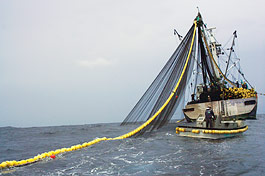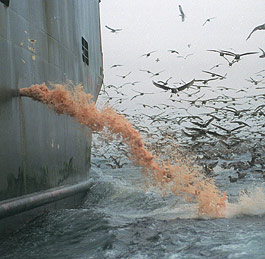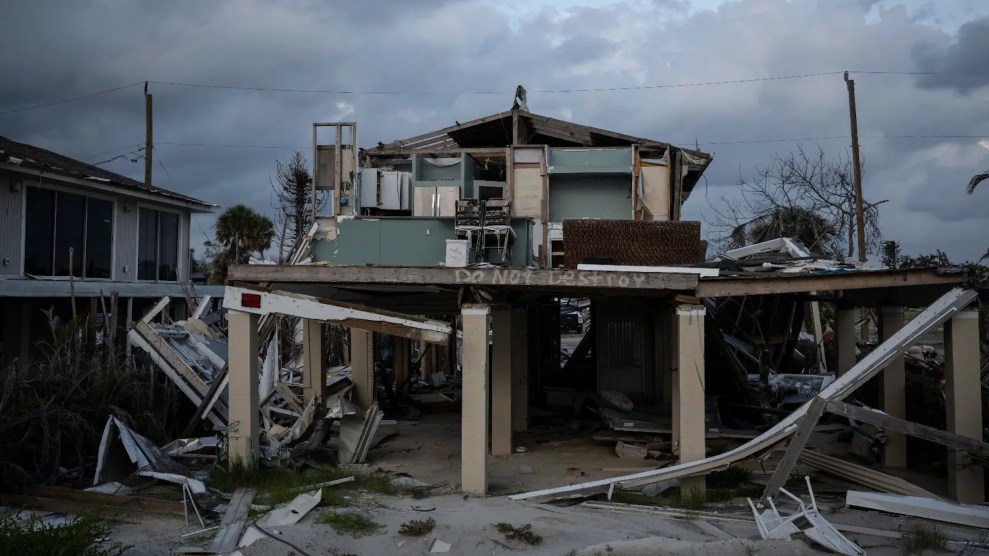
Photo: Greenpeace/Roger Grace
OUT ON THE OPEN ATLANTIC, the approach of darkness brings no end to work on a lone fishing boat that hauls in multiple catches a day, 24 hours a day, from the Georges Bank shoals. Isabel S. is not one of those wooden Winslow Homer dories manned by yellow-slickered oarsmen. It’s a 95-foot steel-hulled trawler, powered by a 1,000-horsepower Caterpillar diesel V-8 engine and manned by a crew of five men—captain, mate, engineer, cook, and deckhand—who work in shifts around the clock for as long as they are fishing, usually for a week at a time. The boat’s hold can carry 180,000 pounds of fish layered in crushed ice, though owner Robert Lane says he rarely carries more than half that.
The weather on the North Atlantic in February ranges from uncomfortable to hostile, with air temperatures in the 20s and water temperatures in the 40s, and wave heights commonly exceeding 6 to 12 feet. The winds are relentless. At this time of year, a man overboard in heavy seas could survive only a short while. “When the seas start running up to 20 feet,” Lane says, “we knock off and lay to. It’s too risky to have the men out on deck under those conditions.” Lucrative as it can be, commercial fishing is one of the most dangerousoccupations in America.
Incongruously, it’s also a business freighted with paperwork. Fishing is so heavily regulated by the federal government that Jeffrey Hatfield, who’s run this boat for Lane for 17 years, boards Isabel S. lugging a briefcase full of regulatory documents. Trawler owners like Lane, along with long-liners like Mike Russo—who runs Susan Lee out of Chatham, Massachusetts—spend much of their time trying to stay on top of groundfish regulations like the infamous Amendment 13, a document that’s four inches thick. The effectiveness of all that paper is another story. “The hardest thing about this fishery is the year-to-year uncertainty,” Russo says. “The plans take so long to develop that they’re defunct by the time we get them, and the rules change so often it’s impossible for me to do a business plan.” Both boat operators are savvy about their industry and belie the stereotype of the rapacious fisherman bent on catching every last fish. They understand conservation. And both are deeply frustrated. “The lack of fish isn’t going to do me in,” Russo says. “The management of the fishery is going to do me in.”
Aboard Isabel S. on a typical trip, Hatfield and his crew don’t suffer from a lack of fish: Working the controls of the massive hydraulic winches, Hatfield winds a 220-foot-long green nylon net aboard. For two hours, the net has been dragging along the seafloor at 30 fathoms. When the bottom of the net, the cod end, rises into sight bulging with two-foot-long silvery fish, Hatfield winches it high over the stern and dumps the entire haul onto the deck.
A good multispecies haul consists of about 3,000 pounds of haddock, plus some cod, whiting, pollack, sea dab, and the inevitable dogfish (an abundant small shark). Haddock is the money fish, the reason Isabel S. ventures out on Georges Bank at this time of year. Two crew members stand knee-deep in wet fish to sort the catch, tossing different species into different bins. The crewmen, veterans of years of work on Lane’s boats, eviscerate the fish and clean them with a hose before lowering them into the hold in canvas baskets. Below, the catch is packed neatly in layers of crushed ice.
With haddock selling at a market price of $1.37 per pound, just one haul could bring owner Lane and his crew a gross payment of $4,110. Four days of such work could load the hold with 50,000 pounds of haddock, which, when off-loaded and weighed at a dockside processor back in New Bedford, would garner a check to the captain of $68,500. The payout goes this way: Money is deducted for overhead—20 tons of crushed ice, crew supplies, and 5,600 gallons of diesel fuel—then something for the boat, an allotment for the owner, and shares for the captain and the crew. That’s good money for the people who do the wet dirty work, and good fish for us, America’s millions of seafood consumers. All well and good?
No. Commercial fishing is a deeply troubled industry, caught between a freebooting past in which high seas fishing was a free-for-all among fishermen who behaved as if the fish in the sea were inexhaustible—and a future in which fish populations are known to be finite, with many threatened or even facing extinction. The world’s oceans—including U.S. waters—have been overfished for decades, causing long-term disruption to marine ecosystems. Many commercially important fish stocks, like the legendary Atlantic cod, are seriously depleted despite many years of federal and state regulation. According to the latest numbers from the Department of Commerce, at least 28 percent of the fish stocks are officially “overfished” and another 19 percent are “subject to overfishing.”
The crisis isn’t uniform: Atlantic cod are overfished. Haddock are currently plentiful. Red snapper are chronically overfished. Sea scallops are not. So are we actually running out of fish? “No,” says Paul Rago, a marine biologist with the National Oceanic and Atmospheric Administration (NOAA). “We don’t utilize the ocean resource very well, but we haven’t altered the productivity of the world’s oceans.”
But we have been catching and consuming a significant number of important fish species faster than they can reproduce. Demand for seafood is growing worldwide, and U.S. consumption is climbing to record levels. In 2004, demand rose for the third straight year as Americans ate 16.6 pounds of fish and shellfish per capita. Though farm-raised fish now supply a large portion of that consumption, U.S. fisheries can no longer meet demand; more than half our seafood is imported from all over the globe.
Coastal nations like the United States are struggling to manage their ocean fisheries sustainably but without much success. Regulating commercial fishing is a devilishly complex challenge featuring many compelling— and competing—commercial, environmental, social, and political interests. This year has seen the biggest surge of federal legislation in a decade, with a number of bills pending in Congress. But the biggest question persists: how to manage an essential but vast and atomized industry in which the stocks are wild, the stakes are high, the science is uncertain, and the regulatory tools are not only arcane but anachronistic?
 A factory trawler fishing for pollack discharges ground-up bycatch.
A factory trawler fishing for pollack discharges ground-up bycatch.OCEAN FISH are a commonly held natural resource. Fish are wild animals. The haddock swimming on Georges Bank theoretically belong to the American public but actually belong to no one until caught by the crew aboard a boat like Lane’s trawler. Moreover, catching ocean fish is an act of hunting, an oddly atavistic method of securing food supplies for the modern world. Unlike domestic animals, wild fish can’t really be “managed.” “You cannot control the fish,” notes Tom Nies, a senior fishery analyst with the New England Fishery Management Council. “You can only control the fishermen.”
And that isn’t easy. States rule the fishing in their waters up to three miles out. Beyond that, to a distance of 200 miles, our Exclusive Economic Zone, commercial fishing is regulated by the U.S. government, specifically NOAA’s Fisheries Service. Mostly a conventional federal bureaucracy, NOAA also conducts the scientific research upon which all regulations are purportedly based, through its six research centers such as those in Woods Hole, Massachusetts, and La Jolla, California.
But the core of NOAA’s regulatory work is conducted by a unique and controversial set of eight regional councils whose makeup and methods seem intrinsically to favor industry interests over conservation. With appointees from both the public and private sectors, the councils determine every aspect of fishing in their region, functioning like a local quasi-independent authority. They spell out exactly which fish species can be caught, along with where, when, how, and how many. The councils’ distribution—from New England and the Mid-Atlantic to the Gulf of Mexico and the North Pacific—reflects the fisheries themselves, which vary from place to place in U.S. waters.
Under the best of circumstances, with perfectly accurate and timely scientific data, and fishermen who are always wise and cooperative, it would still be tricky to balance the long-term health of the fish stocks, the economic interests of the fishermen, and the interests of the general public. But some long- standing characteristics of the councils make it difficult for them to overcome the decades-long legacy of overfishing.
Prime among these is the fact that most of the nongovernmental voting members of the councils are insiders, direct participants in the fisheries they’re regulating. Most are commercial fishermen, boat owners, seafood processors, or operators of recreational charter boats—people with financial interests. Consequently, the councils are dominated by the same industry that is exploiting the natural resource the councils are charged with conserving. No other federal regulatory agency works this way.
Under the 1976 Magnuson-Stevens Act (which was revised in 1996), governors of coastal states nominate the councils’ appointed members, who are supposed to be “knowledgeable regarding the conservation and management, or the commercial or recreational harvest, of the fishery resources of the geographical area concerned.” Of New England’s 12 appointed members, eight are from the commercial sector, three are in recreational fishing, and one is from an environmental group (the lone environmentalist in all eight councils). Of the North Pacific’s seven members, six are from the commercial sector.
If this doesn’t exactly amount to putting the foxes in charge of the chicken coop, it raises troubling conflict-of-interest issues. Curiously, the councils are legally exempt from government conflict-of-interest standards. The systemic vulnerability to conflicts troubles some voting members of the councils. Rip Cunningham, a first-term appointee to the New England Council and chairman of its important Groundfish Committee, has a lifelong interest in recreational fisheries as former editor of Salt Water Sportsman magazine. “I consider that I’m on the Council to represent the fish,” he says, conceding the dominance of the commercial interests in New England. Still, he notes that “the appointees are much more broad-minded than they were 10 years ago and willing to work together—but that situation varies from council to council.”
Not all council members are so sanguine. Attorney and recreational fisherman James Fensom served two terms as a Florida appointee on the Gulf of Mexico Council, including a 2002-2003 stint as council chair. Early in 2005, Fensom declined to serve a third term, writing a blistering letter to Governor Jeb Bush, who had appointed him. Noting that the Gulf Council had been singled out by many critics, he wrote that the next appointee “should not be in a leadership position in any fishing organization, should not be a commercial or recreational fisherman who generates income by harvesting fish, should not be an immediate family member of a scientist who receives grants from the National Marine Fisheries Service, and should not be a family member of an employee of the National Marine Fisheries Service.” Fensom added that during his two terms, “there has never been a member who has declared a conflict of interest on an issue and declined to vote,” and some members with a financial stake in the outcome of a vote “strain all logic and applicable science in an effort to maintain current [fishing] limits.”
At least one flagrant instance of an ongoing conflict of interest in the Western Pacific Council was detailed in a 2003 prize-winning series by editor Paul Koberstein in the Cascadia Times of Portland, Oregon. The series chronicled the voting record of two business partners, Jim Cook and Sean Martin, who operate a company in Honolulu that supplies gear to commercial fishermen. For a time, Cook chaired the Western Pacific Council, and Martin is a current member. While engaged in longline fishing, Martin moved to open a turtle reserve area to the practice, even though long-lining has been known to seriously threaten four species of endangered sea turtles. (The motion passed.) Meanwhile, Cook has reportedly been fined for illegal lobster harvesting, and their company, Pacific Ocean Producers, has been fined for illegally fishing in protected waters and other violations.
While not always so obvious, the conflict- of-interest issue is embedded in council culture. During a recent meeting of the New England Council, through two and a half days of discussion and votes, not a single member requested recusal. More striking, at the March 2005 NOAA conference, Vice Admiral Conrad Lautenbacher Jr., undersecretary of commerce for oceans and atmosphere—the NOAA administrator—said in a speech: “I don’t believe in this great conflict-of-interest issue. I don’t think we have that on our fishery management councils. It’s not been a problem, anyway.”
But in surveys conducted to help assess the council system, many members have revealed their discomfort over conflicts of interest. They continue to cast votes on regulatory matters, perhaps because most see themselves as representatives of specific industry constituencies, such as Maine lobstermen, rather than the vague general public. Indeed, “the council system encourages that attitude,” notes Josh Eagle, an attorney who headed up the Stanford Fisheries Policy Proj- ect and was lead author of its critical report on the system.
The problem, say Fensom and others, goes beyond the specific conflict of any individual member. “It is contrary to human experience and common sense to expect certain members to vote against the direct financial interest of the industry represented by an individual member,” he said in his resignation letter from the Gulf Council. “It is unfair to the council process and the individual members to place these members in such a moral, financial, and ethical conflict.”
MANY CRITICS of fishery management point to another serious conflict inherent in the councils: They are responsible for both conservation and allocation decisions. “The councils decide how many fish can be caught and who can catch them,” says Eagle. “Because larger catches are easier to divide up among competing fishery interests, the councils’ responsibility to allocate catches encourages them to set lax fishery limits, undermining conservation.”
Two recent far-reaching reports, one by the Pew Oceans Commission in 2003 and another by the U.S. Commission on Ocean Policy in 2004, expressed strong concern about this issue (among many others) and recommended that science should determine catch levels—that is, how many fish can sustainably be taken from the sea—while the councils should determine how those catches are allocated. Councils currently regulate allocation through “limited entry,” or boat permits; by controlling “effort,” which entails such steps as limiting the number of fishing days at sea; or by quotas, a strict limit on how many pounds can be caught in a season. Each of these methods comes with problems. Of regulating effort, for example, New England council member Cunningham says, “it’s as if the Bureau of Land Management were attempting to regulate the timber industry by restricting the size of the chain saws. It doesn’t work.”
Currently, only the North Pacific Council—which many experts regard as a model—is effective at setting and monitoring strict quotas, which go against the grain of many fishermen. According to fishery analyst Tom Nies, the New England Council tried so-called hard quotas for groundfish in the ’70s and ’80s, “but it didn’t work. There were problems with setting the quotas, and the fishermen cheated.”
Critics admit that such quotas could benefit larger fishing operations over smaller fishermen. But right now, “they’re the best management tool,” asserts Lee Crockett, executive director of the Marine Fish Conservation Network. “Reach the limit and you close [the fishing] down.” Of course, not everyone agrees: “There’d be a mushroom cloud if you went to quotas in New England,” says long-liner Russo. “There’s a 300-year-old fishing community here and it hasn’t changed much.”
As things now stand, the scientific conclusions about a given fish stock are advisory. “If a council doesn’t do what it is supposed to,” says Andrew Rosenberg, a former NOAA Northeast regional administrator now at the University of New Hampshire, “there isn’t much you can do about it. You can’t sue a council.” All too often over the years—even decades—some councils have overridden the scientific conclusions and set catch limits that were too high.
And yet, setting unsustainably high catch limits can’t be understood as a simple matter of the councils’ making corrupt decisions: The Magnuson-Stevens Act requires them to take into account the socioeconomic impacts of their decisions on coastal communities. By law, marine science alone does not carry the day, so NOAA’s regional science centers also employ social scientists, economists, and anthropologists.
Complicating the issue further is the imprecision of the science. By statute, fishing regulations are based on the “best scientific information available,” so for over 40 years NOAA has run a sizable research operation through its regional science centers, employing 1,400 scientists and technicians. Their task includes assessing, for each of the hundreds of commercial fish species, the average age, size, weight, gender, rates of reproduction, locations, movements, feeding habits, and predator-prey relationships. They also gauge the impacts of the fishing itself.
An experienced marine biologist can often determine a fish’s age just by looking at its scales, much the way tree rings reveal a tree’s age. Of course, NOAA scientists can’t count all the fish in the sea, so they do a lot of sampling and computer modeling. “It’s like pulling a thimble two feet through a room, then counting the dust motes caught in the thimble and trying to estimate the quantity of dust in the whole room,” says John Boreman, director of the research center in Woods Hole. “It’s a big ocean and we have small nets.” Samples can show, for instance, that the cod being landed are mostly three or four years old, whereas “we know that Atlantic cod live for about 15 years,” Boreman notes. “That tells you something important about the stock.”
While the so-called fishery management plans include staggering amounts of data, skepticism of the science runs high among fishermen. “People sometimes see the answers that they want,” says Rosenberg. “And one of them is, ‘Well, you know, we’re catching more red snapper, therefore the science must be wrong.’” Many critics of NOAA praise the scientists’ expertise. But with so much—investments, careers, family, mortgages, and community well-being—riding on regulatory decisions, it’s tempting to question the data.
“There is a lot of debate about the science centers’ numbers, a lot of screaming,” says senior analyst Nies, who heads up the team that writes the controversial groundfish plans in the New England region. “The dirty little secret is that even with really good science, there is still a lot of uncertainty about the stocks.” But if that uncertainty opens the door to regulatory decisions that result in overfishing, the science, says Eagle, is sure on one point: “We know enough to know that there’s trouble out there, and we ought to manage the fisheries accordingly.”
Whether to separate conservation and allocation decisions is currently being debated within NOAA and on Capitol Hill. At the same March 2005 conference when agency administrator Lautenbacher denied the conflict-of-issue problem, a panel on fisheries governance also dismissed the idea of dividing conservation and allocation, calling it “illogical.”
But at the same conference, Lee Crockett of the Conservation Network presented a paper that detailed the potentially disastrous consequences of setting catch levels higher than scientific findings support. In the Pacific region, for instance, the Pacific rockfish had been so overfished for two decades that the secretary of commerce declared the fishery “a disaster” and ordered it closed down. Red snapper in the Gulf of Mexico are “severely depleted,” though so far, despite legal requirements, there’s no recovery plan in sight. And in New England, “year after year, cod landings have exceeded target catch levels by 100 to 300 percent,” Crockett said. “Despite ample scientific evidence showing that groundfish stocks are severely overfished and not rebuilding, the New England Council continues to base its management decisions on economic and political considerations.”
AFTER 10 YEARS without new fishing legislation, multiple bills are pending in the wake of the Pew and U.S. commission reports, with several directed at reauthorizing the Magnuson-Stevens Act (MSA). Both the White House and Senate have floated reauthorization bills, the latter by Senator Ted Stevens (R-Alaska), coauthor of the original legislation, and Senator Daniel Inouye (D-Hawaii). It’s likely that Stevens’ bill will effect some needed incremental changes, such as promoting greater use of science in councils’ management decisions, strengthening some conflict-of-interest rules, requiring every management plan to set catch limits below what the scientists conclude is sustainable (“the optimum yield” of the fishery), and setting national guidelines for management tools like limiting access to fisheries and establishing “individual fishing quotas.”
But these improvements are a long way from the systemic changes that many critics believe are needed. “We lack leadership on this issue,” says Rep. Sam Farr (D-Calif.), who represents the Monterey Bay area and is an originator of the House Oceans Caucus. “The councils are under terrific pressure, and until the laws make them more diverse, they are going to err on the side of the commercial interests. We do need a legislative fix, but Congress is not leading on the ocean issues.” Farr also does not see much help coming from the White House, pointing out that Bush’s plan to reauthorize the MSA is “a slight step backward, as its provisions weaken the existing act by allowing more overfishing.”
Congress is unlikely to dismantle the culture of conflicts in the councils, to divorce the conservation and allocation decision making, to improve accountability for the councils’ decisions, or to mandate the management tools like hard quotas that could stop overfishing and facilitate rebuilding the depleted fish stocks in as short a time as possible. Nor, for that matter, is it likely to address issues the fishermen themselves have with the ways the councils regulate their business—the pace, the perceived fairness, and the stability of the management decisions.
Another factor in the lack of political will is the relative low visibility of the issues. Americans love fish, but they’re not moved by fish conservation the way they are by, say, animal rights. Without a strong public constituency, there’s little political pressure to counterbalance fishing industry interests.
Some of those most concerned about conservation are the fishermen, who after all have a huge stake in the future of the oceans. With Isabel S. docked in her historic New Bedford home port for maintenance, longtime owner Lane sits in the pilothouse and considers the fisheries management conundrum. In yet another reflection of how tangled the regulatory issues can get, at times he sounds as much like an environmentalist as a businessman. “I’d reduce pressure on the fish stocks with a buyout of permits,” he says, adding that fishermen have gone so far as to suggest that the New England Council shut down some fisheries altogether until the stock recovers, only to see their suggestions ignored. Lane, like others, has grown cynical about the council system, saying he rarely goes to meetings and, like many New England fishermen, is considering getting out of the business. It’s a sentiment that says as much as any report, a sure sign that the system needs to change.















